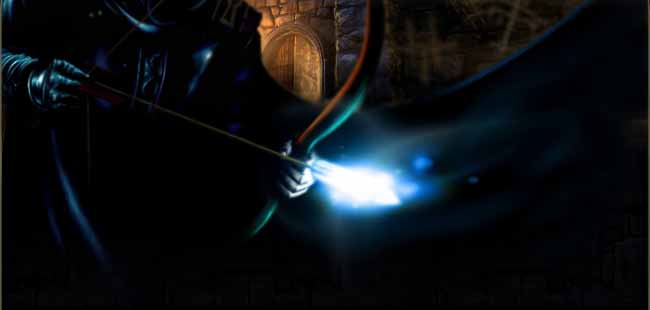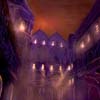|
Courtyard > The City |
Let us begin. As you walk around this room, you will find examples of the obstacles and opportunities that present themselves within the City. Most of the objects and information you see here is taken for granted by those that live here. With the proper training, however, you will learn to take nothing for granted and will instead see an object for its true worth.

The first topic we will cover is information - for information is what we Keepers hold dear. On this table lay several objects, all of which are used to contain information of a kind.
 |
Books are a common source of information. They can usually be found laying on tables or other surfaces, and can be read by using them. Books typically contain journals, ledgers, stories, or any other information intended for permanent storage. Books come in various shapes and sizes but are usually rectangular in shape. |
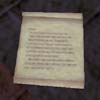 |
Parchment is often used for the writing of temporary lists and notes. An example of something written on parchment would be a quick note reminding someone of something, or perhaps a letter sent from one individual to another. Parchments must usually be picked up before reading, but can sometimes be read without picking them up first. Parchments are also occasionally found attached to walls or doors whenever something is being announced to everyone in the area. |
 |
Scrolls are usually a piece of parchment that has been rolled into a cylinder. Scrolls usually contain information that one would carry with them, such as maps, instructions, or item lists. Scrolls must always be picked up before one can read them, which is logical considering one must unroll the scroll to see its contents. |

The second topic we will cover is how to reach the information you need. The objects we've just discussed are often behind a locked door or window. Such would prove an obstacle for most, but should be a simple matter for a Keeper.
 |
Doors are taken for granted by most. After all, mankind learned to place doors on even the mud-forged huts of his ancient past. As you know, doors come in various shapes and sizes but are most often seen as a man-sized rectangular piece of wood or metal. Doors are attached to hinges on one side and swing open when pushed or pulled. These facts are known, are they not? Perhaps not all doors will appear as such, apprentice. Think on this while we discuss the other items before us. |
 |
Windows are another thing most people take for granted. They let the light and air in, yes, but keep the cold and insects out at night. Properly locked from within, they should also keep unwanted intruders out. Not all windows are properly locked, however, and such may be the key to entry if required. Learn to check windows when other ways are barred. |
 |
Locks are what makes our doors and windows safe, but with sufficient skill or force any lock can be picked. Even after a lifetime of practice, apprentice, you will not be able to open every lock you cross, but many will open before your skill before you are done. Do not pass up an entryway simply because it is locked. Always try your luck with the lockpicks before moving on. |

The next topic we will cover is light - for what is the art of stealth if not a study of light? The table before you includes examples of the various light sources you may find in the City. We have seperated these into the ones you can extinguish and the ones you must avoid or pass through.
The following are those which can be extinguished - usually by means of a single water arrow...
 |
Torches are still the most common light source in the City. Torches are usually a simple sconce mounted to the wall which contains flammable material or liquid. The flame of a torch produces a significant amount of light, but is unreliable as it must not only be relit on occasion but is also vulnerable to water or wind. A single water arrow is sufficient to extinguish a torch. |
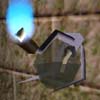 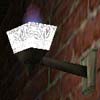 |
Gas Lamps were introduced to the City by the Hammerites and provide a somewhat more reliable light source than the average torch. Gas Lamps are powered by a liquid fuel similar to oil which usually resides in a container beneath the lamp. The fuel is than lit producing a bright blue flame which produces more light than a torch. In addition to the added light, a gas lamp is usually not affected by wind or slight moisture. If a water arrow is shot directly into the flame, however, it is still sufficient to extinguish the lamp. At least two varieties of gas lamp are in widespread use throughout the City - those which are enclosed in a glass globe and those which are open to the air. The globe varieties are somewhat more protected against the elements, but are more difficult to light when necessary. For this reason the more popular of the two is the less protected open-air version, in which one only has to touch a torch to the wick to light the lamp. |
 |
Fireplaces are common throughout the City as they provide both light and heat. Many inhabitants of the City also use fireplaces to cook on, which makes them a common sight in kitchens as well as other rooms of a house. Regardless of its size, a single water arrow is usually sufficient to extinguish a lit fireplace. |
The following light sources cannot be extinguished by water, but it may be possible to turn off such lights by other means...
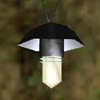 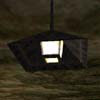 |
Electric Lights were an innovation of the Hammerites and were later improved upon by the Mechanists. Despite the current unpopularity of the Mechanists, the use of their improved electric lights has become fairly widespread. Many have apparently forgotten who gave them this new wonder. The people of the City cannot be faulted for their practicality, however. Electric lights may be more expensive to operate then the traditional torch or gas lamp, but these lights are not susceptible to the elements and cannot be extinguished even with a water arrow. Most electric lights are powered by a facility owned by the City and operated by the Hammerites. For a time, a seperate facility was run by the Mechanists as well, but it has since been annexed by the City and is now used as a secondary power source. Since the power source is external to the lights in this fashion, they are impossible to turn off locally. Such lights must either be avoided entirely or passed by. Others, however, can be turned off using a switch or console nearby. |
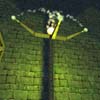 |
Gas Lights were introduced to the City nearly a hundred years ago. These lights are powered by a system of piping beneath the City, and can only be turned off by the City Works department. Water arrows have no effect on gas lights, and they cannot be extinguished by any other means. |

Now we will discuss the methods with which you can manipulate the world around you. Most machinery and many electric lights are controlled by a nearby switch or console. You must learn to look for such items when entering an area. We will therefore cover each type briefly.
 |
Switches are still the most common control mechanism in the City. Affordable and easy to repair, a switch is simply a lever that moves between two positions - on and off. Switches can be found in situations where a device or machine comes on automatically once power is introduced. To turn off the machine, simply use the switch. |
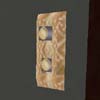 |
Lightswitches are switches which toggle a light source on and off. This type of switch is usually somewhat ornamental and is found on many estates and upper-class establishments. In most industrial areas, a basic switch is used instead. |
 |
Consoles are usually found in areas that require more power than a simple switch can provide. This type of control mechanism usually powers or disables doors, security systems or lights for an entire neighborhood. Large machinery such as those found in Hammerite or formerly Mechanist facilities may also require a console. |
 |
Buttons are used to trigger a single action. These are most often seen when using elevators or other types of lifts - one button is assigned to each floor and must be pressed to travel to that floor. Buttons are also used to trigger specific functions of machinery in some industrial areas. |
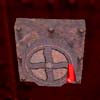 |
Winches are primarily seen in industrial areas. They are usually attached to a cable or some other system that slowly expands or contracts to perform a function. This control mechanism is often used to open or close large grates and doors, particularly those located within sewers or other areas of the City's subterranean piping system. |
 |
Levers are actually a throwback to nearly a hundred years ago. In those days, mechanisms such as doors and gates were operated by a simple large lever which operated a nearby winch or other similar device. Levers have become popular again in certain areas - perhaps in a protest of sorts against the recent onslaught of technology - and can of course still be found in buildings and structures from that era. |

The inhabitants of the City use many different containers to store items in - barrels, crates, boxes, and chests. Here we will discuss these containers and how they can best be used by a Keeper.
 |
Barrels are round cylinders which stand about five spans high. They are hollow and are usually used to store foodstuffs, grain, and other perishable goods. Barrels are heavy and cannot be picked up or carried. They can, however, be used as a stepping block if they are near a ledge or other reachable surface. |
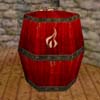 |
Flammable Barrels are barrels which are used to store flammable fuel or materials. By decree of the City Council, any such barrel must be painted bright red with a large white flame present on its front or side. Such barrels can be ignited with a flame arrow and will produce a powerful explosion - much like that of an explosive device. |
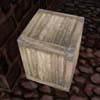 |
Small Crates are used to store non-perishable goods. They can often be found in storerooms, closets, or industrial areas. These crates can usually be picked up and carried, or even thrown if the situation requires. Small crates can also be stacked in various configurations, allowing one to create steps where none existed before. |
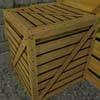 |
Large Crates can be found in many industrial areas - primarily those surrounding warehouses or other storage facilities. Large crates are much too awkward and heavy for carrying, but some can be opened providing access to whatever goods are stored within. Others can be climbed and used to reach higher areas. |
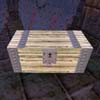 |
Lockboxes are similar to chests in that they provide a secure container in which to store valuable or fragile goods. While not as structurally sound or ornamental as a chest, a lockbox is protected by a lock yet is also stackable like a crate. Lockboxes can usually be found in storerooms, closets, or other areas wherein a chest is impractical or unaffordable. |
 |
Chests provide a secure container in which valuable items or goods can be stored and protected. Chests are usually made of sturdy material - heavy wood or metal, for instance - with a lock on the outside to prevent unwanted access. Chests come in various shapes and sizes but are usually somewhat ornamental in appearance. Because of their variety and ornamentation, chests are usually not stackable. |
 |
Safes represent the ultimate in storage security. These boxes are made of a sturdy and heavy metal with riveted hinges and a complex lock system. With patience and skill, however, even a safe is vulnerable to the use of lockpicks. |

Of course, one should also learn of the animals we share this City with. Many are harmless, but not all. The ones which can hurt a Keeper - spiders, carrion divers, and burricks - can be found across the courtyard in the Enemies chamber. Those which are harmless, however, will be covered briefly here.
 |
Rats are small furry creatures which scuttle about the floor in search of food and nesting. They can usually be found in storerooms, cellars, and dungeons. These creatures are fairly harmless and will only bite if picked up or agitated. Rats can be heard scurrying about and will also make noise if stepped on. |
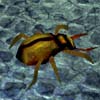 |
Rustmites are harmless to people but are considered the bane of architects and the City Works department. These large golden beetles feed off of nutrients found only in metal. Because of this they substantially weaken the metal used in the construction of buildings, lampposts, etc. The Hammerites, in particular, despise the insects and have placed a bounty on them. |
 |
Fish are found only in the bay and pose no threat to humans. In fact, this animal is considered a major supply of food and can often be seen in meatlockers or other refrigerated areas. |
 |
Cats are not that common throughout the city, but can be found in some establishments and estates. These creatures are kept by some to keep down the rat population and others as pets. Cats will not harm a person but may make noise if startled or stepped on. |
Obviously you will encounter more objects in the City than we can possibly cover here. Through experience in the field you will learn how to manipulate your environment and use surrounding objects to your utmost advantage. Until then, however, you must learn these lessons well and commit them to memory. You show great promise, apprentice, but only through time and patience will you become what you may yet be.

